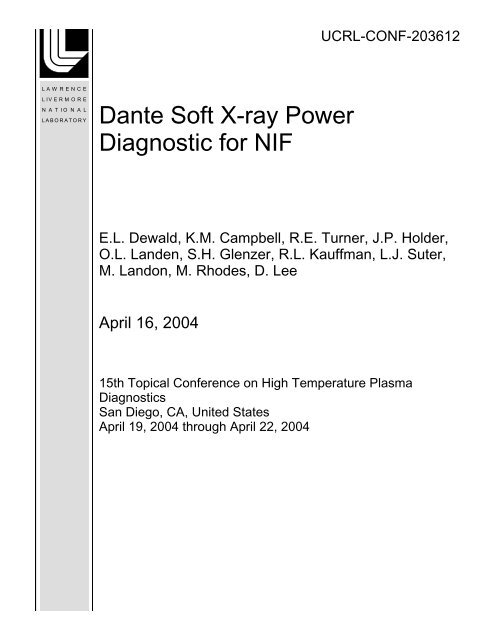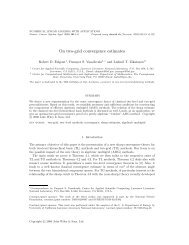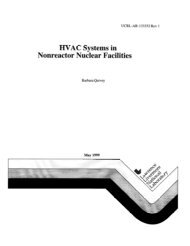Dante Soft X-ray Power Diagnostic for NIF - Lawrence Livermore ...
Dante Soft X-ray Power Diagnostic for NIF - Lawrence Livermore ...
Dante Soft X-ray Power Diagnostic for NIF - Lawrence Livermore ...
You also want an ePaper? Increase the reach of your titles
YUMPU automatically turns print PDFs into web optimized ePapers that Google loves.
<strong>Dante</strong> <strong>Soft</strong> X-<strong>ray</strong> <strong>Power</strong><br />
<strong>Diagnostic</strong> <strong>for</strong> <strong>NIF</strong><br />
UCRL-CONF-203612<br />
E.L. Dewald, K.M. Campbell, R.E. Turner, J.P. Holder,<br />
O.L. Landen, S.H. Glenzer, R.L. Kauffman, L.J. Suter,<br />
M. Landon, M. Rhodes, D. Lee<br />
April 16, 2004<br />
15th Topical Conference on High Temperature Plasma<br />
<strong>Diagnostic</strong>s<br />
San Diego, CA, United States<br />
April 19, 2004 through April 22, 2004
Disclaimer<br />
This document was prepared as an account of work sponsored by an agency of the United States<br />
Government. Neither the United States Government nor the University of Cali<strong>for</strong>nia nor any of their<br />
employees, makes any warranty, express or implied, or assumes any legal liability or responsibility <strong>for</strong><br />
the accuracy, completeness, or usefulness of any in<strong>for</strong>mation, apparatus, product, or process<br />
disclosed, or represents that its use would not infringe privately owned rights. Reference herein to any<br />
specific commercial product, process, or service by trade name, trademark, manufacturer, or otherwise,<br />
does not necessarily constitute or imply its endorsement, recommendation, or favoring by the United<br />
States Government or the University of Cali<strong>for</strong>nia. The views and opinions of authors expressed herein<br />
do not necessarily state or reflect those of the United States Government or the University of Cali<strong>for</strong>nia,<br />
and shall not be used <strong>for</strong> advertising or product endorsement purposes.
<strong>Dante</strong> <strong>Soft</strong> x-<strong>ray</strong> <strong>Power</strong> <strong>Diagnostic</strong> <strong>for</strong> <strong>NIF</strong><br />
E.L. Dewald, K.M. Campbell, R.E. Turner, J.P. Holder, O.L. Landen, , S.H. Glenzer, ,<br />
R.L. Kauffman, L.J. Suter, M. Landon, M. Rhodes and D. Lee<br />
Experimental <strong>NIF</strong> requirements<br />
<strong>Soft</strong> x-<strong>ray</strong> power diagnostics are essential <strong>for</strong> measuring spectrally resolved the total x<strong>ray</strong><br />
flux, radiation temperature, conversion efficiency and albedo that are important<br />
quantities <strong>for</strong> the energetics of indirect drive hohlraums. At the Nova or Omega Laser<br />
Facilities, these measurements are per<strong>for</strong>med mainly with <strong>Dante</strong> [1], but also with DMX<br />
[2] and photo-conductive detectors (PCD’s) [3]. The <strong>Dante</strong> broadband spectrometer is a<br />
collection of absolute calibrated vacuum x-<strong>ray</strong> diodes, thin filters and x-<strong>ray</strong> mirrors used<br />
to measure the soft x-<strong>ray</strong> emission <strong>for</strong> photon energies above 50 eV.<br />
Compared to NOVA and Omega laser facilities, the National Ignition Facility is designed<br />
to achieve indirect drive ignition and to provide a considerably extended range of laser<br />
drive flux and thus higher radiation temperatures in the target. Figure 1 shows the range<br />
of laser driven soft x-<strong>ray</strong> flux and the predicted radiation temperatures <strong>for</strong> different target<br />
designs. The flattop hohlraum curves shows the range of soft x-<strong>ray</strong> flux that can be<br />
obtained in hohlraum experiments <strong>for</strong> full <strong>NIF</strong> laser power and variable hohlraum size<br />
and the NEL (<strong>NIF</strong> early light) curve shows the similar dependence obtained <strong>for</strong> full<br />
power of the first <strong>NIF</strong> quad only. The Ignition hohlraum curve gives the range of flux and<br />
radiation temperature emitted through the hohlraum laser entrance hole (LEH) during the<br />
ICF ignition Haan laser pulse. The <strong>NIF</strong> and NEL peak power curves are obtained <strong>for</strong> the<br />
peak <strong>NIF</strong> and NEL laser power considering a variable open source size that is smaller<br />
than the <strong>Dante</strong> field of view <strong>for</strong> 100% conversion efficiency from laser energy into soft<br />
x-<strong>ray</strong>s.<br />
X-Ray<br />
<strong>Power</strong><br />
(W/sr)<br />
10 14<br />
10 13<br />
10 12<br />
10 11<br />
10 10<br />
10 9<br />
<strong>NIF</strong> Peak <strong>Power</strong> Foil<br />
<strong>NIF</strong> Flattop Hohlraum<br />
<strong>NIF</strong> Ignition<br />
NEL Peak <strong>Power</strong> Foil<br />
NEL Flattop Hohlraum<br />
NEL Pulse-Shaped<br />
100 T (eV) 1000<br />
r<br />
Figure 1<br />
Compared to the <strong>Dante</strong> spectrometers used at NOVA and Omega laser facilities [1], the<br />
<strong>Dante</strong> developed <strong>for</strong> <strong>NIF</strong> will have more broad band channels at > 2keV photon energies<br />
due to the higher expected radiation temperatures, as well as a central imaging channel<br />
and a photo-conductive detector, as shown in Figure 2. Moreover, <strong>NIF</strong> <strong>Dante</strong> will have a<br />
considerably increased dynamic range. The imaging channel will measure the radiation<br />
source size, position and uni<strong>for</strong>mity, while the PCD will sample the radiation flux<br />
emitted by the target in the central part of the source that is not affected by source
Target<br />
5.5 m<br />
Central channel<br />
w 100 µm<br />
Imaging<br />
Pinholes<br />
2 cm<br />
Collimators<br />
3 m<br />
New<br />
Filters and<br />
Grids 18 channels<br />
Mirrors<br />
PCD<br />
10-100 ns Gated<br />
MCP/CCD<br />
Detector<br />
5 GHz Digitizers<br />
Diodes<br />
Cable<br />
compensators<br />
boundary non-uni<strong>for</strong>mities. The average detector stand-off distance will be 8.5 m and the<br />
field-of-view of the <strong>Dante</strong> channels, defined by collimators is ±30 mm.<br />
Figure 2 <strong>Dante</strong> <strong>for</strong> <strong>NIF</strong> layout<br />
The broad band energy channels of <strong>Dante</strong> <strong>for</strong> <strong>NIF</strong><br />
As shown by Figure 1 the new <strong>Dante</strong> spectrometer will be used to measure radiation<br />
temperatures up to 1 keV and fluxes in the 10 10 to 10 14 W/cm 2 . The high photon energy<br />
limit of the <strong>Dante</strong> channels is given by its requirement to measure 96-99% of the total<br />
drive radiation flux. Considering a Planckian black body spectrum, this requirement is<br />
met <strong>for</strong> photon energies of ≤10 kTr, where Tr is the radiation temperature. Since <strong>for</strong> full<br />
<strong>NIF</strong> laser power radiation temperatures approaching 1 keV are predicted analytically,<br />
<strong>Dante</strong> will have 18 broad band channels up to 10 keV photon energies as shown in figure<br />
2. These channels will consist of x-<strong>ray</strong> diodes, mirrors and filters as given in Table 1,<br />
depending on the experiment.<br />
Table 1 Energy channels of <strong>Dante</strong> <strong>for</strong> <strong>NIF</strong><br />
Low energy resolved channels, similar to <strong>Dante</strong> working on the Omega laser facility<br />
New high energy channels, similar to DMX
The absolute measurement error is given by the calibration procedures used to measure<br />
the response functions of the XRD’s, x-<strong>ray</strong> mirrors and filters on the synchrotron at the<br />
Brookhaven National Laboratory with a goal of better than 20% in x-<strong>ray</strong> flux. The first,<br />
lower energy 12 channels that cover energies up to 1.8 keV are similar to those of <strong>Dante</strong><br />
installed at the NOVA and Omega laser facilities, whereas the 7 higher energy channels<br />
will be newly added to cover the photon energy range between 1.8 and 10 keV [2]. As<br />
shown in Table 1, the channels measuring photon energies below 500 eV have both x-<strong>ray</strong><br />
edge filters and mirrors to discriminate the filter edge contribution from the high energy<br />
contribution that could, in the absence of the mirror generate large errors in the low<br />
energy radiation flux measurements. On the other hand, the channels used <strong>for</strong> photon<br />
energies above 500 eV use filters only currently, with the option of adding low angle<br />
mirrors in the future <strong>for</strong> Channels 4 – 6.. The high energy contribution far above the filter<br />
edges is then subtracted from each soft individual channel signal using the higher energy<br />
channels.<br />
For crosscheck and data continuity purposes, the x-<strong>ray</strong> diodes that will be used <strong>for</strong> the<br />
new <strong>Dante</strong> are similar to those installed on the Omega and NOVA laser facilities and<br />
have a time response better than 200 ps. The signals expected <strong>for</strong> each individual channel<br />
were calculated considering radiation flux and temperature curves shown in figure 1. For<br />
optimal measurements with the XRD’s connected to signal cables with 50 Ω impedance,<br />
the signal levels should be well above the expected <strong>NIF</strong> noise level of 50 mV and below<br />
the Child-Langmuir limited XRD saturation level of 500 V. Figure 3a shows the signals<br />
predicted <strong>for</strong> the lower limit of the <strong>NIF</strong> 1 st quad curve that will be available soon <strong>for</strong><br />
experiments.<br />
10 1<br />
Minimum 1<br />
Significant<br />
Signal<br />
(V)<br />
0.1<br />
0.01<br />
Expected noise<br />
level<br />
100 1000 10000<br />
E (eV)<br />
Max<br />
Signal<br />
(V)<br />
10000<br />
1000<br />
100<br />
10<br />
signals w/o attenuation grids<br />
XRD saturation level<br />
signals w 5,10 or 20x<br />
attenuation grids<br />
100 1000 10000<br />
E (eV)<br />
a b<br />
Figure 3 Predicted signal levels <strong>for</strong> (a) minimum signal predicted <strong>for</strong> the first quad and<br />
(b) maximum signal of the full <strong>NIF</strong> curves (Fig. 1) without and with<br />
transmission grids
The minimum flux and temperature predicted <strong>for</strong> NEL yields signal levels considerably<br />
higher than the expected noise level. For the upper limit of full <strong>NIF</strong> power predicted<br />
fluxes and temperatures (Fig. 3b), the signals <strong>for</strong> several channels are 5-20 times higher<br />
than the 500 V XRD saturation level. For these high radiation fluxes x-<strong>ray</strong> attenuation<br />
grids will be used to decrease the signal below the saturation point. The transmission<br />
grids are the only viable solution since the required increase in filter thickness would<br />
result in dominance by high energy components well above edges, causing an<br />
unacceptable error increase in determining the filter edge flux component. Such grids or<br />
pinhole ar<strong>ray</strong>s have been used as achromatic filters <strong>for</strong> PCDs [4].<br />
High frequency signal attenuators will be used to decrease further the measured signals<br />
from the maximum of 500 V XRD saturation level to 10 V which is the upper limit that<br />
can be measured with high speed analogue oscilloscopes.<br />
Except <strong>for</strong> the signal level, the data acquisition system has to satisfy the dynamic range<br />
requirements <strong>for</strong> the planned experiments. Figure 4 shows the required dynamic range<br />
shot-to-shot at full <strong>NIF</strong> encompassing the range of Trs shown in Fig. 1 and <strong>for</strong> the shaped<br />
ICF radiation flux.<br />
Dynamic<br />
Range<br />
100000<br />
10000<br />
1000<br />
100<br />
10<br />
Shot-to-shot<br />
Single-shot ICF<br />
(Haan pulse: 50-350 eV)<br />
1<br />
100 1000<br />
E (eV)<br />
10000<br />
Figure 4 Dynamic range required <strong>for</strong> the different <strong>Dante</strong> channels shot-to-shot <strong>for</strong> full<br />
<strong>NIF</strong> power as well as <strong>for</strong> the ICF Haan pulse (Fig. 1)<br />
While the shot-to-shot, full <strong>NIF</strong> and peak power dynamic ranges do not have to be<br />
achieved within one shot, the ICF Haan pulse dynamic range of maximum 11 bits has to<br />
be covered by the acquisition system in order to measure the x-<strong>ray</strong> flux and radiation<br />
temperature on both foot and peak power laser pulse regions. Since the modern<br />
oscilloscopes do not exceed 6 bit at 5 GHz frequency imposed by the required time<br />
resolution, signal multiplexing will be used to resolve separately the foot and the peak<br />
power fluxes.<br />
<strong>Dante</strong> PCD and Imaging channel<br />
As mentioned above, the <strong>Dante</strong> imaging channel will be used to measure the source size<br />
and location time integrated over the x-<strong>ray</strong> pulse in order to ensure XRD alignment to the<br />
radiation source. It consists of four 100 µm diameter imaging pinholes with 0.5<br />
magnification and a low gain x-<strong>ray</strong> microchannel plate (MCP) protected by a thin Be
filter and connected to a CCD camera as shown in Figure 5. For measured photon<br />
energies higher than 500 eV, the diffraction limited resolution ranges from 400 µm at 300<br />
Target<br />
M = 0.5x<br />
5.5 m 2.8 m<br />
Optional<br />
filters<br />
4 pinholes<br />
100 µm<br />
Image 1<br />
Images 2- 4<br />
PCD<br />
Low gain<br />
4x4 cm MCP<br />
Detector<br />
e in the 10 4 -10 6 photons/µm 2 V to 150 µm <strong>for</strong> 3 keV x-<strong>ray</strong>s, with an estimated flux<br />
range.<br />
Figure 5 Layout of the <strong>NIF</strong> <strong>Dante</strong> imaging channel<br />
Three of the images <strong>for</strong>med on the MCP will be used to measure the source size,<br />
distribution and location as well as to measure the soft x-<strong>ray</strong> contribution of the plasma<br />
generated by the unconverted IR and green laser light in the <strong>Dante</strong> FOV. Placed in front<br />
of the MCP, a PCD 0.3x0.3x0.3 mm<br />
e shadow cast<br />
y the PCD on the MCP will be used to verify the PCD-source alignment.<br />
3 in size will be centered on the fourth image using a<br />
high precision motor driven 2-dimensional positioner to sample the x-<strong>ray</strong> flux in the<br />
uni<strong>for</strong>m region of the x-<strong>ray</strong> radiation source. This will give a time resolved, spectral<br />
integrated flux measurement and by comparison with the XRD flux will be used to assess<br />
the effects of temporal changes in the radiation source distribution on the measured flux.<br />
With the imaging pinholes of 100 um and predicted radiation fluxes (Fig. 1), the expected<br />
PCD signal is in a non-saturated regime with an amplitude up to 15 V. Th<br />
b<br />
Conclusion<br />
The <strong>Dante</strong> spectrometer <strong>for</strong> <strong>NIF</strong> is the core diagnostic <strong>for</strong> hohlraum per<strong>for</strong>mance and <strong>for</strong><br />
other soft x-<strong>ray</strong> flux measurements. Through its increased number of XRD channels at<br />
photon energies >2 keV and its newly developed imaging channel, it is designed to<br />
accommodate various types of experiments and to measure with a precision better than<br />
5% radiation temperatures in the 50 eV to 1 keV range. The higher dynamic range<br />
required by ICF and other type of experiments as compared to NOVA and Omega laser<br />
facilities<br />
will be satisfied by the use of signal multiplexing.<br />
References<br />
[1] H.N. Kornblum, R.L. Kauffmann and J.A. Smith, “Measurement<br />
of 0.1-3 keV x-<strong>ray</strong>s<br />
from laser plasmas”, Rev. Sci. Instrum. 57, 2179 (1986)<br />
[2] J.P. Bourgade, B. Villette, et al, “DMX: An absolutely calibrated, time resolved<br />
broadband soft x-<strong>ray</strong> spectrometer<br />
designed <strong>for</strong> MJ class laser produced plasmas” Rev.<br />
Sci. Instrum. 72, 1173 (2001)<br />
[3] D.R. Kania, L. Pan, H. Kornblum, P. Bell, O.L. Landen, and P. Pianetta, “<strong>Soft</strong> x-<strong>ray</strong><br />
detection with diamond photoconductive detectors”, Rev. Sci. Instrum. 61, 2765 (1990)<br />
[4] R.E. Turner, O.L. Landen, P. Bell, R. Costa and D. Hargrove, “Achromatically<br />
filtered diamond photoconductive detectors <strong>for</strong> high<br />
power soft x-<strong>ray</strong> flux<br />
measurements”, Rev. Sci. Instrum. 70, 656 (1999).<br />
FO<br />
CCD







